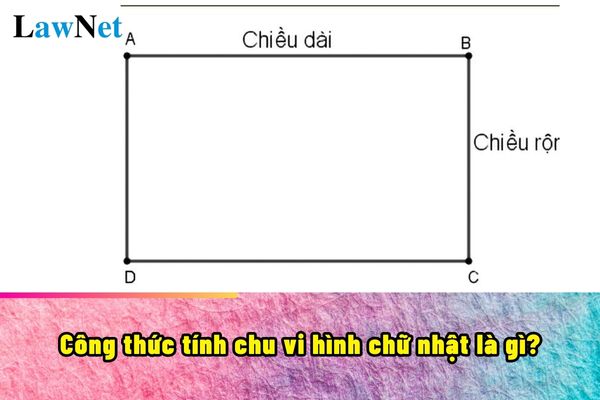What is the formula for calculating the perimeter of a rectangle? When do students in Vietnam learn the formula for calculating the perimeter of a rectangle?
What is the formula for calculating the perimeter of a rectangle?
The formula for calculating the perimeter of a rectangle is as follows:
|
P = (length + width) x 2 Where: P = (8 + 5) x 2 = 26 cm Unit of measurement: The unit of measurement for the perimeter will be the same as the unit of measurement for length and width (e.g., cm, m, km). |
Note: The information is for reference purposes only./.

What is the formula for calculating the perimeter of a rectangle? When do students in Vietnam learn the formula for calculating the perimeter of a rectangle? (Image from the Internet)
When do students in Vietnam learn the formula for calculating the perimeter of a rectangle?
Based on Section V of the Appendix on the Mathematics Education Program issued with Circular 32/2018/TT-BGDDT, the formula for calculating the perimeter of a rectangle will be taught in the Grade 3 Mathematics curriculum as follows:
- Ability to perform conversions and calculations with measurements of length (mm, cm, dm, m, km); area (cm²); mass (g, kg); volume (ml, l); time (minutes, hours, days, weeks, months, years); and Vietnamese currency learned.
- Can calculate the perimeter of triangles, quadrilaterals, rectangles, and squares when the side lengths are known.
- Can calculate the area of rectangles and squares.
- Ability to estimate measurement results in some simple cases (e.g., the weight of a chicken is about 2kg,...).
- Can solve some practical problems related to measurement.
Thus, according to the regulations, the formula for calculating the perimeter of a rectangle is taught in Grade 3.
What are principles for developing the primary level Mathematics curriculum in Vietnam?
Based on Section II of the Appendix on the Mathematics Education Program issued with Circular 32/2018/TT-BGDDT, the following principles must be ensured when developing the Mathematics curriculum:
The Mathematics curriculum adheres to the basic regulations stated in the General Program; inherits and promotes the strengths of the current program and previous programs, selectively assimilates the experiences of curriculum development in advanced nations worldwide, approaches the achievements of educational science, while considering the economic and social conditions of Vietnam.
Additionally, the Mathematics curriculum emphasizes the following principles:
Principle 1. Ensuring simplicity, practicality, and modernity
The Mathematics curriculum ensures simplicity, practicality, and modernity by reflecting essential contents that must be addressed in school, meeting the need to understand the world and the interests and hobbies of learners, and aligning with the world's current approaches.
The curriculum embodies the spirit of "mathematics for everyone", enabling anyone to learn mathematics but allowing each individual to study mathematics in a way suitable to their interests and abilities.
It emphasizes practical applications and interlinks with other subjects and educational activities, especially those involved in STEM education, aligning with modern development trends in economics, science, social life, and pressing global issues (e.g., climate change, sustainable development, financial education,...).
This is also demonstrated through practical and experiential activities in mathematics education in various forms such as projects, mathematics study clubs, forums, conferences, and competitions to facilitate students applying their knowledge, skills, and experience creatively.
Principle 2. Ensuring consistency and continuity in development
The Mathematics curriculum ensures consistency and continuous development (from Grade 1 to Grade 12), comprising two tightly linked branches: one describing the development of core knowledge strands and the other describing the development of students' skills and qualities.
Furthermore, it ensures a seamless connection with the pre-primary education program and lays the foundation for vocational education and higher education.
Principle 3. Ensuring integration and differentiation
The Mathematics curriculum implements in-subject integration around three knowledge strands: Numbers, Algebra and some elements of Calculus; Geometry and Measurement; Statistics and Probability; and interdisciplinary integration through related topics or mathematical knowledge utilized in other subjects such as Physics, Chemistry, Biology, Geography, Informatics, Technology, History, Art,...;
It accomplishes in-subject and interdisciplinary integration through practical and experiential activities in mathematics education.
Simultaneously, the Mathematics curriculum ensures differentiation. At all educational levels, it embodies a spirit of individualized instruction based on ensuring that the majority of students (across all regions of the country) meet the program’s required standards while paying attention to special groups (gifted students, students with disabilities, students in difficult circumstances,…).
For secondary education, the Mathematics curriculum includes specialized study modules and learning content that helps students enhance their knowledge, practical skills, and apply problem-solving related to real life.
Principle 4. Ensuring openness
The Mathematics curriculum ensures a unified orientation and core compulsory mathematical education content for all students nationwide while granting autonomy and responsibility to localities and schools in selecting and supplementing additional mathematical education content and implementing educational plans suitable to the local conditions and the specific needs of the schools.
The program specifies general guidelines, targets, and general principles regarding the learning outcomes, educational content, teaching methods, and assessment of educational results, avoiding overly detailed regulations to enable authors of textbooks and teachers to exercise initiative and creativity in implementing the curriculum.
The program ensures stability and development flexibility during implementation to align with scientific and technological advancements and real-world demands.
>>> See more Preparing for the overview of the cell in Biology 10 according to Canh Dieu curriculum in Vietnam
>>> See more Preparing lessons included in the textbook Mathematics 10 according to Volume 1 Canh Dieu curriculum in Vietnam
>>> See more Guideline for preparing the lesson Thanh âm của gió for grade 5 students in Vietnam
>>> See more Guideline for preparing the lesson nouns, verbs, and adjectives for grade 5 students in Vietnam
>>> See more Guideline for learning the lesson of word practice and sentences (Pronouns) for grade 5 students in Vietnam
>>> See more Short essay describing the teacher for grade 5 students in Vietnam for the school year 2024-2025
>>> >>> Download the Mathematics Education Program issued with Circular 32/2018/TT-BGDDT.

